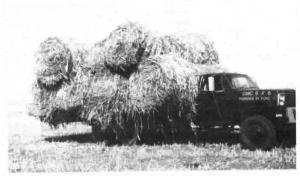1989 - Volume #13, Issue #5, Page #07
[ Sample Stories From This Issue | List of All Stories In This Issue | Print this story
| Read this issue]
Army Truck 14-Bale Hauler
 |
 |
Moellering built the rack from eight 4-ft. long sections of 4-in. dia. pipe arranged in two cradles which are tilted inward. Each cradle holds four bales so Moellering can put eight bales on the bottom layer and six bales on top for a total of 14 bales. The pipes on the rack telescope out to 101/2 ft. wide (16 in. on each side) in loaded position from the 8 ft. wide unloaded position.
"This truck is especially good for long distance hauling when I have to move bales 10 to 30 miles," says Moellering, who operates a welding shop and a custom bale hauling service. "The truck's 3-speed transmission is geared down allowing me to `walk' at 5 mph with the engine wide open or go up to 55 mph. The truck's suspension isn't overloaded even when hauling fourteen bales weighing 1,400 lbs. apiece."
Moellering bought the Army truck for $500 and stripped everything away except the frame and running gears. He lengthened the frame 4 ft. and then cut off the cab and replaced it with a more stylish cab from a 1980 Chevrolet pickup. He replaced the truck's original 302 cu. in. 6-cylinder diesel engine with a Ford 400 8-cylinder diesel engine, and replaced the automatic transmission with a beefed up Ford C-6 3-speed transmission. He re-placed the air-over-hydraulic brakes with vacuum booster brakes removed from a Chevrolet dump truck and installed power steering from a Chevrolet C-65 truck. "If I were to do it over, I'd use a 460 cu. in. engine because the 400 cu. in. engine is a little short of horsepower when I'm hauling a full load and bucking the wind. But with 6-WD and a geared down ratio I can go through a lot."
Moellering welded the pipe sections together and bolted them to the truck frame with eight 1/2-in. bolts. Extension pipes slide out the end of each pipe and the weight of the bales keeps them in place. Moellering loads and unloads bales with a front-end loader. During transport he ties a red flag onto each corner of the truck and also fastens a "wide load" sign on the front bumper.
For short distance hauling, Moellering uses 12-ft. wide double-bale forks mounted on the front and back of his Deere 4430 tractor. One fork is 3-pt. mounted. The other fork bolts onto dozer blade brackets on front of the tractor. Both forks are built from 2 by 4, 1/4-in. thick steel tubing and are equipped with prongs made from 3 by 3 3/16 in. steel tubing.
"Hauling four bales at once, I've moved 40 bales an hour traveling a half mile each way," says Moellering. "Hauling four bales instead of one reduces soil compaction because I'm not driving back and forth as much. Also, bales don't fall apart when you cradle them like they can when you stab them, so I can safely haul bales with rotted twine."
Contact FARM SHOW Followup,John Moellering, Rt. 1, Box 40, Grinnell, Kan. 67738 (ph 913 824-3456).

Click here to download page story appeared in.

Click here to read entire issue
To read the rest of this story, download this issue below or click here to register with your account number.




